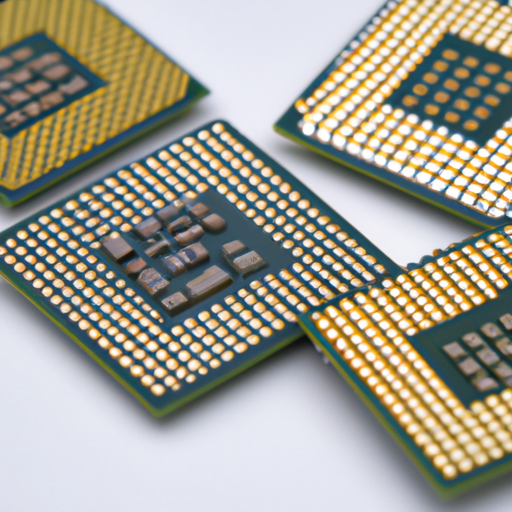

The global microprocessor market size is expected to reach $79.2 billion by 2026, according to a report by Grand View Research. This growth is driven by the increasing demand for high-performance computing devices in various industries such as automotive, healthcare, and consumer electronics.

One of the key drivers of the microprocessor market is the increasing adoption of cloud computing and data centers. With the growing amount of data being generated and processed every day, there is a need for faster and more efficient processors to handle this workload. This has led to the development of advanced microprocessors with higher processing speeds and lower power consumption.
Another factor driving the growth of the microprocessor market is the increasing demand for connected devices. With the proliferation of smart devices such as smart TVs, smart home appliances, and wearable devices, there is a need for microprocessors that can handle the processing requirements of these devices. This has led to the development of specialized microprocessors for specific applications, such as graphics processing units (GPUs) for gaming consoles and artificial intelligence processors for machine learning applications.
The automotive industry is also a key driver of the microprocessor market. With the increasing adoption of electric vehicles and autonomous driving technologies, there is a growing demand for microprocessors that can handle the complex processing requirements of these systems. This has led to the development of specialized automotive-grade microprocessors that are designed to withstand harsh operating conditions and provide high levels of reliability and performance.
In addition to these drivers, the increasing demand for high-performance computing in industries such as healthcare, aerospace, and defense is also fueling the growth of the microprocessor market. These industries require microprocessors that can handle complex calculations and simulations, as well as provide real-time processing capabilities for critical applications.
Despite the growth opportunities, the microprocessor market faces several challenges, such as the increasing complexity of chip designs, the rising cost of semiconductor manufacturing, and the growing competition from alternative technologies such as field-programmable gate arrays (FPGAs) and application-specific integrated circuits (ASICs). However, with advancements in semiconductor technology and the development of new materials and manufacturing processes, the microprocessor market is expected to continue growing in the coming years.
In conclusion, the global microprocessor market is poised for significant growth in the coming years, driven by the increasing demand for high-performance computing devices in various industries. With the rise of technologies such as artificial intelligence, machine learning, and the Internet of Things, the need for more powerful and efficient microprocessors is on the rise. Despite facing challenges such as increasing complexity and competition, the microprocessor market is expected to continue growing and evolving to meet the demands of the digital age.
The global microprocessor market size is expected to reach $79.2 billion by 2026, according to a report by Grand View Research. This growth is driven by the increasing demand for high-performance computing devices in various industries such as automotive, healthcare, and consumer electronics.

One of the key drivers of the microprocessor market is the increasing adoption of cloud computing and data centers. With the growing amount of data being generated and processed every day, there is a need for faster and more efficient processors to handle this workload. This has led to the development of advanced microprocessors with higher processing speeds and lower power consumption.
Another factor driving the growth of the microprocessor market is the increasing demand for connected devices. With the proliferation of smart devices such as smart TVs, smart home appliances, and wearable devices, there is a need for microprocessors that can handle the processing requirements of these devices. This has led to the development of specialized microprocessors for specific applications, such as graphics processing units (GPUs) for gaming consoles and artificial intelligence processors for machine learning applications.
The automotive industry is also a key driver of the microprocessor market. With the increasing adoption of electric vehicles and autonomous driving technologies, there is a growing demand for microprocessors that can handle the complex processing requirements of these systems. This has led to the development of specialized automotive-grade microprocessors that are designed to withstand harsh operating conditions and provide high levels of reliability and performance.
In addition to these drivers, the increasing demand for high-performance computing in industries such as healthcare, aerospace, and defense is also fueling the growth of the microprocessor market. These industries require microprocessors that can handle complex calculations and simulations, as well as provide real-time processing capabilities for critical applications.
Despite the growth opportunities, the microprocessor market faces several challenges, such as the increasing complexity of chip designs, the rising cost of semiconductor manufacturing, and the growing competition from alternative technologies such as field-programmable gate arrays (FPGAs) and application-specific integrated circuits (ASICs). However, with advancements in semiconductor technology and the development of new materials and manufacturing processes, the microprocessor market is expected to continue growing in the coming years.
In conclusion, the global microprocessor market is poised for significant growth in the coming years, driven by the increasing demand for high-performance computing devices in various industries. With the rise of technologies such as artificial intelligence, machine learning, and the Internet of Things, the need for more powerful and efficient microprocessors is on the rise. Despite facing challenges such as increasing complexity and competition, the microprocessor market is expected to continue growing and evolving to meet the demands of the digital age.